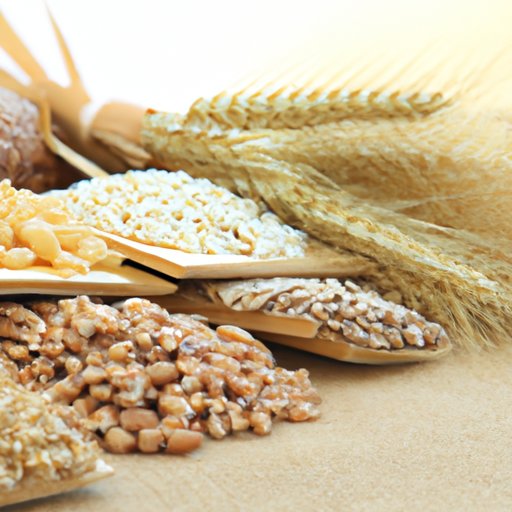Introduction
Grains have been a dietary staple for centuries, playing an integral role in human nutrition. But with the rise of low-carb diets, there’s been a lot of debate over whether or not grains are actually good for us. So, what’s the truth? Are grains bad for you?
To understand the answer, it’s important to first define what we mean by “grains.” According to the Academy of Nutrition and Dietetics, grains include wheat, oats, rice, barley, corn, quinoa, millet, sorghum and other cereal grains. These grains can be eaten as whole grains, meaning they contain all three parts of the original grain (the bran, germ and endosperm), or as refined grains, meaning some of the original parts have been removed. Both types of grains provide essential vitamins and minerals that are necessary for our health and wellbeing.

Exploring the Pros and Cons of Eating Grains
The health benefits of grain consumption are well established. Whole grains are rich sources of fiber, vitamins, minerals, phytonutrients, and antioxidants, which can help reduce the risk of heart disease, stroke, cancer, and type 2 diabetes. Studies have also shown that whole grain consumption is associated with improved cognitive function, better digestive health, and healthier bodyweight.
However, it’s important to note that there are potential risks associated with eating too many grains. Refined grains, such as white bread and white rice, are often stripped of important nutrients, making them less nutritious than whole grains. Additionally, people who have a gluten sensitivity may need to avoid certain grains altogether. It’s important to speak with a doctor or dietitian to determine which grains are right for you.
When it comes to nutrition, it’s also important to consider the variety of grains you’re consuming. Different types of grains offer different nutritional value, so it’s best to mix up your grain choices to ensure you’re getting a wide range of vitamins, minerals, and phytonutrients. Quinoa, for example, is a great source of plant-based protein, while oats are packed with soluble fiber.

Decoding the Latest Research on Grain Nutrition
Studies have found that whole grains provide a number of important vitamins and minerals, including vitamin E, magnesium, phosphorus, zinc, and B vitamins. Whole grains are also a great source of phytonutrients, which are compounds found in plants that have antioxidant and anti-inflammatory properties. Phytonutrients can help protect against chronic diseases like cancer and heart disease.
When it comes to the health effects of grains, there’s evidence to suggest that whole grains are more beneficial than refined grains. A study published in the American Journal of Clinical Nutrition found that replacing refined grains with whole grains was associated with a lower risk of cardiovascular disease and type 2 diabetes. The study also found that consuming more whole grains was linked to a lower risk of death from any cause.
In terms of weight management, studies have found that increasing whole grain intake is associated with a lower body mass index (BMI). One study published in the journal Obesity even found that replacing refined grains with whole grains was linked to a reduced risk of becoming overweight or obese.

The Role of Grains in a Healthy Diet
Most experts recommend that adults consume at least three servings of whole grains each day. That’s about one-half cup of cooked grains, such as oatmeal, brown rice, quinoa, or bulgur. It’s also important to limit your consumption of refined grains, such as white bread and white rice, to no more than one serving per day.
If you’re looking to incorporate more grains into your diet, try adding them to salads, soups, stews, or casseroles. Whole grain cereals, breads, and pastas are also great options. If you’re having trouble finding healthy grain options, look for products labeled “100% whole grain” or “whole wheat.”
Debunking Common Misconceptions About Grains
Despite their numerous health benefits, grains have become something of a scapegoat in recent years. There are a lot of misconceptions out there about grains, including the idea that processed grains are unhealthy. However, this isn’t necessarily true. While it’s important to limit your consumption of highly processed grains, such as white bread and white pasta, there are plenty of healthy, minimally processed grain options available.
Another common misconception is that grains are fattening. In reality, studies have shown that increasing whole grain intake is associated with a lower BMI and a reduced risk of obesity. Of course, it’s still important to practice portion control when it comes to grains, as overeating any food can lead to weight gain.
Conclusion
Grains have long been a dietary staple, offering numerous health benefits. They’re rich sources of fiber, vitamins, minerals, phytonutrients, and antioxidants, which can help reduce the risk of chronic diseases like heart disease, stroke, cancer, and type 2 diabetes. Whole grains are particularly beneficial, but it’s still important to limit your consumption of processed grains.
Overall, grains can be part of a healthy diet, as long as you’re mindful of portion sizes and choosing the right types of grains. To get the most nutritional bang for your buck, aim to eat at least three servings of whole grains each day and mix up your grain choices to get a wide range of vitamins, minerals, and phytonutrients.
(Note: Is this article not meeting your expectations? Do you have knowledge or insights to share? Unlock new opportunities and expand your reach by joining our authors team. Click Registration to join us and share your expertise with our readers.)
